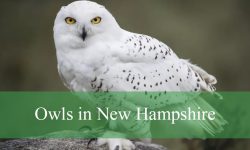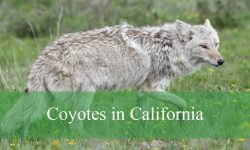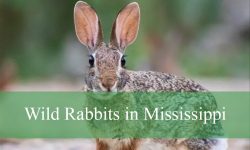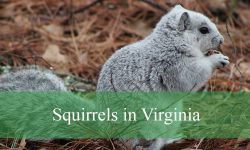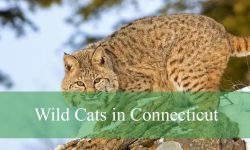In West Virginia’s forests and fields, owls rule the night sky with silent wings and piercing eyes. From the large Great Horned Owl to the tiny Northern Saw-whet Owl, these nocturnal predators captivate birdwatchers with their mysterious presence.
The state’s diverse habitats, ranging from mountainous woodlands to open farmland, provide ideal homes for a variety of owl species. Some, like the Barred Owl and Eastern Screech-Owl, are year-round residents, while others, including the Snowy Owl and Northern Hawk Owl, appear only during rare winter irruptions.
Observing owls in West Virginia requires patience and a keen ear for their calls. Whether perched in a forest canopy, gliding over open fields, or roosting quietly in a tree, each species offers a unique glimpse into the secretive world of these fascinating birds.
Types of Owls in Found West Virginia
Great Horned Owl (Bubo virginianus)
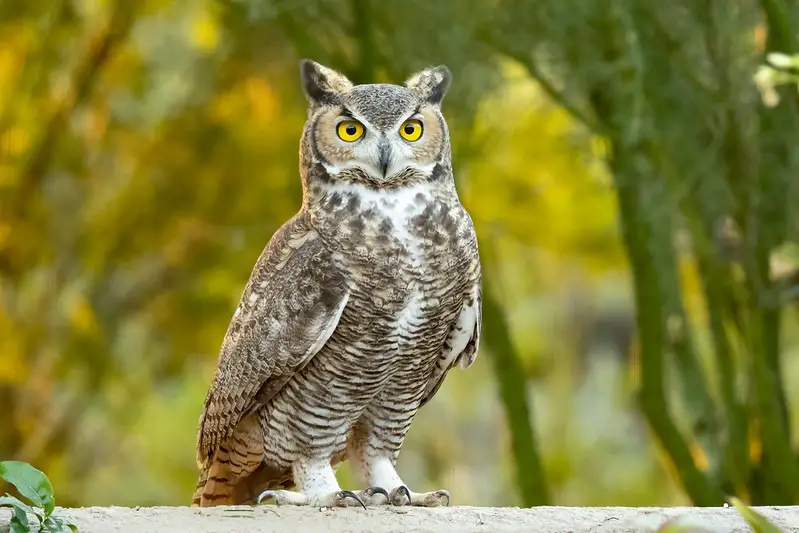
The Great Horned Owl is one of the most powerful and adaptable raptors in West Virginia. With its broad wings, mottled brown plumage, and distinctive feather tufts resembling “horns,” it is easy to recognize. Adults typically measure between 18 to 25 inches long with a wingspan stretching over 4 feet, making them one of the largest owls in the region. Their large yellow eyes give them excellent vision, especially in low light, making them skilled nocturnal hunters.
This owl thrives in a wide variety of habitats across West Virginia, including forests, farmland, and even suburban areas. It does not build its own nest but instead takes over abandoned nests of hawks, crows, or squirrels. Because of its adaptability, it can be found in both the mountains and valleys, often heard calling with its deep, resonant hoots at night.
Great Horned Owls are fierce predators with a diet that includes mammals such as rabbits, skunks, and rodents, as well as birds and reptiles. Their powerful talons allow them to take down prey larger than themselves. They are even known to eat other raptors, showing their dominance in the food chain.
In West Virginia, their haunting calls are a common nighttime sound, particularly in wooded areas. They play a vital ecological role by keeping rodent populations under control. For birdwatchers, spotting a Great Horned Owl is a thrilling experience, often achieved by listening carefully for their hoots in the stillness of the night.
Eastern Screech-Owl (Megascops asio)
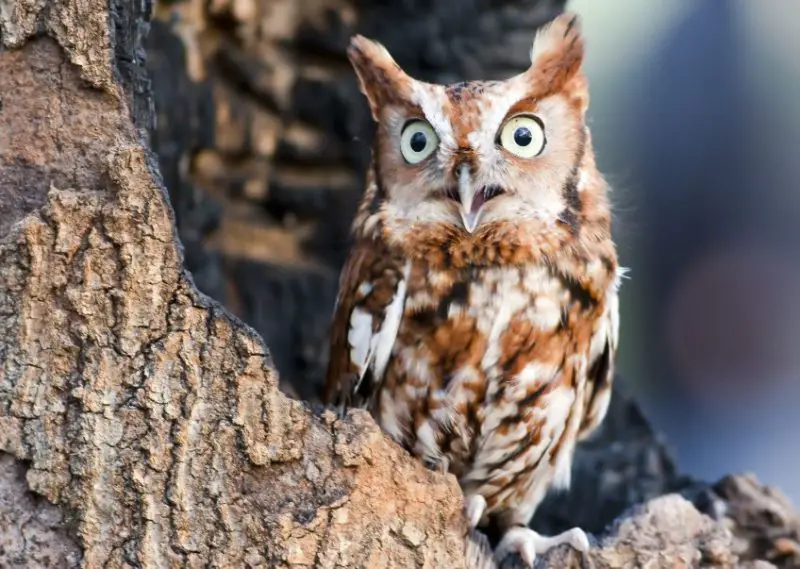
The Eastern Screech-Owl is a small but fascinating owl found throughout West Virginia. Measuring only 6 to 10 inches in length, it is one of the smallest owls in the state. Despite its size, it has excellent camouflage, with gray or reddish-brown plumage that blends seamlessly with tree bark. Its piercing yellow eyes and tiny ear tufts give it a distinctive look when spotted.
This owl prefers wooded areas, orchards, and even backyards with mature trees. In West Virginia, it is commonly found in both rural and suburban environments. Unlike larger owls, it does not migrate and can be seen year-round. They often use tree cavities or nest boxes, which makes them more likely to live near human dwellings.
Eastern Screech-Owls are versatile hunters. Their diet includes insects, small mammals, birds, and amphibians. They are known for their distinctive trills and whinnies, which sound more like a horse’s whinny than a typical owl hoot. These calls often echo through West Virginia forests on warm summer nights.
Although small, they are quite resilient and have adapted well to living near people. Bird enthusiasts often attract them by putting up nest boxes. Their secretive behavior and charming appearance make them a favorite among backyard birders across the state.
Barred Owl (Strix varia)
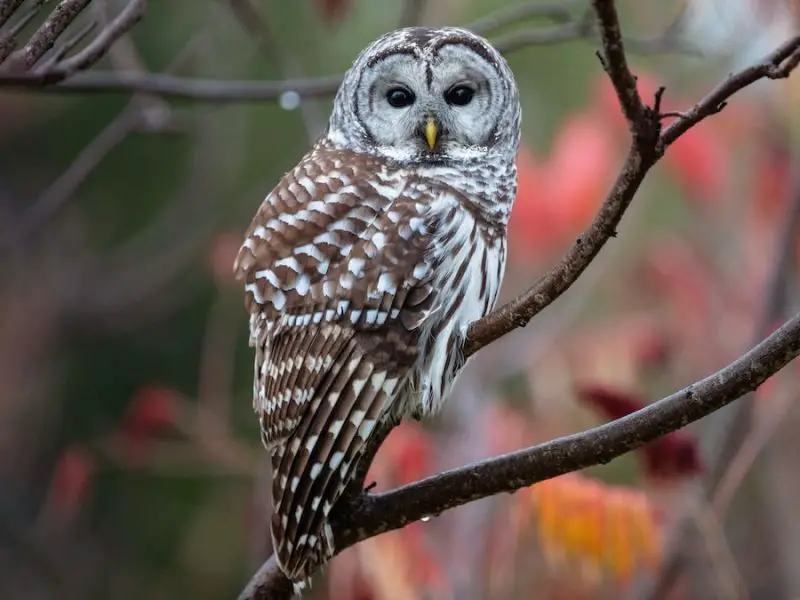
The Barred Owl is a striking bird with rich brown and white streaked plumage and dark, soulful eyes. Unlike most owls that have yellow eyes, the Barred Owl’s deep brown eyes stand out and add to its mysterious look. Adults measure about 16 to 24 inches in length with a wingspan of up to 50 inches, making them a fairly large owl.
In West Virginia, Barred Owls are common in mature forests, wetlands, and river valleys. They prefer areas with dense tree cover near water sources, such as streams and swamps. They are known for their distinct call, often described as sounding like “Who cooks for you? Who cooks for you-all?” which echoes through wooded areas at night.
These owls feed mainly on small mammals, amphibians, and reptiles, but they are also known to catch fish and invertebrates. They are opportunistic hunters, gliding silently through the trees before swooping down on unsuspecting prey. Their ability to adapt their hunting style to different environments allows them to thrive across the state.
Barred Owls are also known for their territorial nature. Once they claim a forested area, they tend to stay there year-round. For West Virginia residents living near wooded wetlands, hearing the loud, rhythmic call of the Barred Owl is a common and hauntingly beautiful experience.
Barn Owl (Tyto alba)
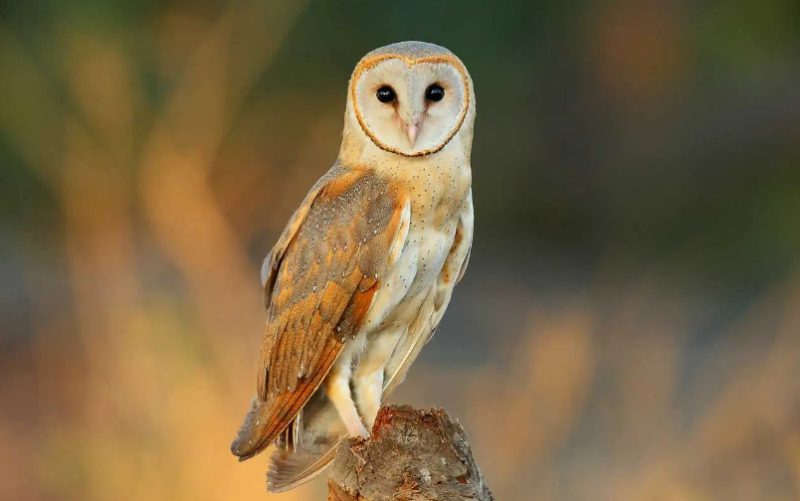
The Barn Owl is one of the most distinctive owls in West Virginia, easily recognized by its heart-shaped white face and golden-buff feathers. It has long wings and legs, with a slender body that gives it a ghostly, elegant appearance. Measuring about 12 to 15 inches long with a wingspan over 3 feet, it is a medium-sized owl but appears larger when in flight.
Barn Owls are typically found in open fields, farmlands, and grasslands across the state. They are strongly associated with agricultural areas where barns, silos, and old buildings provide nesting spaces. Unlike many other owls, Barn Owls prefer wide open spaces rather than dense forests, making them easier to spot hunting over meadows at dusk.
Their diet consists mostly of rodents, making them valuable allies to farmers. They are exceptional hunters, using their incredibly sensitive hearing to locate prey even in total darkness. They swallow their food whole and later regurgitate pellets containing bones and fur.
In West Virginia, Barn Owls are not as common as some other owl species, but they are still present, especially in rural areas. Their eerie, screeching call is quite different from the classic owl hoot and adds to their mysterious reputation.
Short-eared Owl (Asio flammeus)

The Short-eared Owl is a medium-sized owl with a rounded head and very small, often invisible ear tufts. Its plumage is streaked brown and buff, providing good camouflage against grasslands. Measuring about 13 to 17 inches long with a wingspan around 40 inches, it is an agile flier with buoyant, moth-like wingbeats.
In West Virginia, Short-eared Owls are most often seen in open fields, grasslands, and marshy areas. They are not year-round residents but appear mostly in the winter months when they migrate south from northern breeding grounds. Their presence is sporadic, depending on food availability and winter conditions.
Unlike many other owls, the Short-eared Owl is often active during the day, especially in the late afternoon and early evening. This makes them easier to spot as they hunt low over open fields in search of voles and other small mammals. Their flight is graceful, giving the impression of a large moth gliding across the landscape.
Because they prefer open terrain, birdwatchers in West Virginia often look for them in reclaimed strip mines, hayfields, and grassy wetlands. Their day-flying habit and striking appearance make them a rewarding find for those who venture into the right habitats at the right time of year.
Northern Saw-whet Owl (Aegolius acadicus)

The Northern Saw-whet Owl is one of the smallest owls in West Virginia, measuring only 7 to 8 inches in length. Despite its size, it has a round head, large yellow eyes, and no ear tufts, giving it a wide-eyed and curious expression. Its plumage is brown with white streaks on the chest and spots on the head, helping it blend into tree bark with ease.
In West Virginia, this owl prefers dense coniferous and mixed forests, especially in mountainous areas. It is considered secretive and nocturnal, which makes spotting it a real challenge. During migration and winter, some may also move into lower elevations, where birders sometimes discover them roosting in thick evergreens.
Their diet consists mostly of small mammals such as mice and voles, though they also eat insects during warmer months. They hunt primarily at night, swooping down silently from a perch. Their name comes from their high-pitched call that resembles the sound of a saw being sharpened.
Though widespread across North America, they are not commonly seen in West Virginia because of their elusive nature. For dedicated birdwatchers, finding a Northern Saw-whet Owl in the dense forests of the Appalachians is a special reward.
Long-eared Owl (Asio otus)
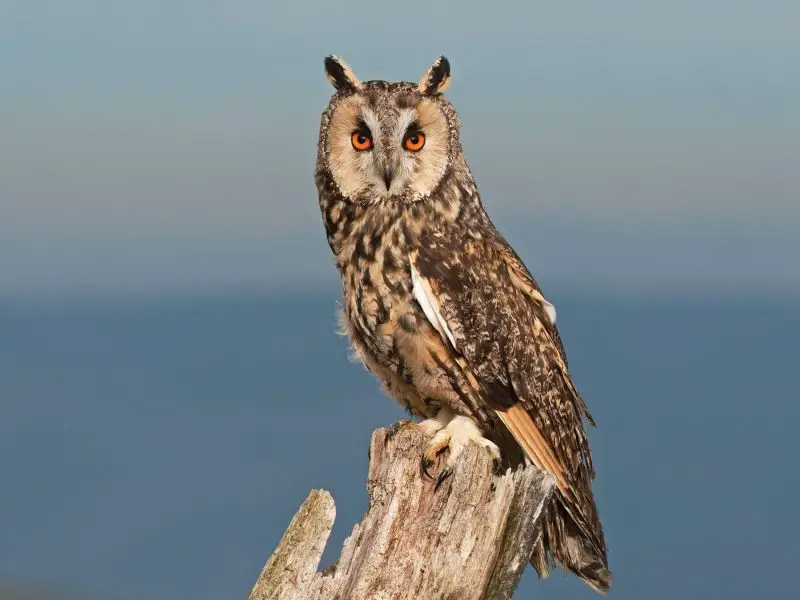
The Long-eared Owl is a medium-sized species with striking orange eyes and tall, narrow ear tufts that give it a very alert appearance. Its plumage is a mottled mix of brown, gray, and buff, providing excellent camouflage among tree branches. Adults measure around 13 to 16 inches in length with a wingspan close to 40 inches.
This owl prefers dense woodlands for roosting but hunts in open grasslands and meadows. In West Virginia, it is mainly a winter visitor, though some individuals may linger year-round in suitable habitats. They often roost in groups during the colder months, making them easier to spot when birders find their communal sites.
Long-eared Owls primarily feed on small mammals such as voles, mice, and shrews. They are skilled nighttime hunters, using their silent flight and keen hearing to track prey. Their call is a series of deep hoots that carry well through quiet forests at night.
Because they are secretive and blend in with their surroundings, sightings in West Virginia can be rare. However, patient birders who know where to look—especially in winter fields bordered by dense woods—sometimes get the chance to observe these elegant owls.
Snowy Owl (Bubo scandiacus)

The Snowy Owl is one of the most striking owls in the world, easily identified by its white plumage marked with black or brown spots. Males tend to be whiter, while females and younger owls show more barring. They are large owls, measuring 20 to 28 inches in length with a wingspan of up to 5 feet. Their piercing yellow eyes stand out against their pale feathers.
Snowy Owls are not regular residents of West Virginia, but they occasionally appear during winter irruptions when food shortages in the Arctic push them south. During these rare events, birders may spot them perched in open fields, airports, or coastal plains, far from their usual tundra habitat.
Their diet in the Arctic is largely lemmings, but when in West Virginia, they adapt to hunting rabbits, squirrels, and birds such as ducks or pigeons. They hunt primarily during the day, unlike most other owls, making them easier to observe when present.
Spotting a Snowy Owl in West Virginia is a once-in-a-lifetime experience for many birdwatchers. Their presence always attracts attention and excitement in the birding community whenever one is reported in the state.
Northern Hawk Owl (Surnia ulula)
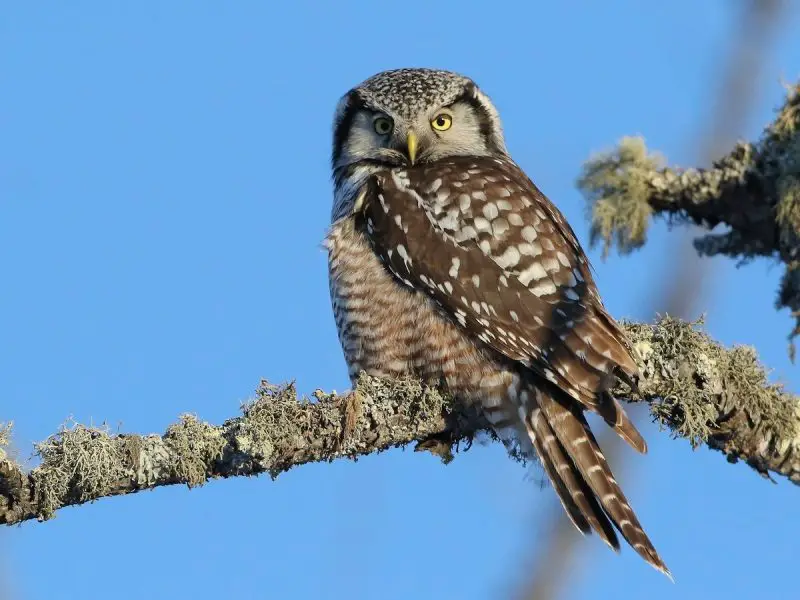
The Northern Hawk Owl is a rare visitor to West Virginia, but its unique appearance makes it memorable. As its name suggests, it resembles a hawk more than a typical owl, with a long tail, slim body, and fast, hawk-like flight. Measuring 14 to 17 inches in length with a wingspan around 28 inches, it has striking yellow eyes and a white face bordered by bold black lines.
In its normal range, this owl inhabits boreal forests of Canada and Alaska, but on rare occasions, it irrupts southward into the northeastern United States, including West Virginia. When present, it favors open areas with scattered trees, fields, and forest edges, where it can perch high and scan for prey.
The Northern Hawk Owl hunts primarily during the day, a trait that sets it apart from most other owls. Its diet includes small mammals, particularly voles and mice, as well as small birds. It often hunts by sight, swooping down from tall perches with remarkable accuracy.
Because it is extremely rare in West Virginia, any sighting of a Northern Hawk Owl is considered an extraordinary birding event. Its diurnal habits and hawk-like behavior make it one of the most unusual owls to ever appear in the state.
Best Time and Places to See Owls in West Virginia
Owls in West Virginia are mostly nocturnal, which means the best time to observe them is during the quiet hours of dusk, night, or early dawn. Species like the Great Horned Owl, Barred Owl, and Eastern Screech-Owl can be heard calling year-round in forests and wooded backyards. Winter nights are particularly good for listening to their territorial calls, as the leaves are off the trees and sounds travel farther through the crisp air.
Open habitats like meadows, reclaimed strip mines, and wetlands provide excellent chances to spot hunting owls such as Short-eared Owls, especially in the colder months. Barn Owls are most often seen in rural farmland, where old barns, silos, and fields attract them. For rarer visitors like Snowy Owls and Northern Hawk Owls, the best time is during winter irruptions, when they move south in search of food and sometimes perch in open areas such as fields or even near airports.
Mountainous forests, such as those in the Monongahela National Forest, are the best places to look for Northern Saw-whet Owls and Long-eared Owls, particularly during migration and winter roosting periods. Listening for their distinct calls at night increases the chances of finding them. Birders who venture into quiet woodlands or wide-open fields with patience, especially at dusk, have the greatest success observing these mysterious night hunters in West Virginia.
FAQs about Owls in West Virginia
What species of owls are found in West Virginia?
West Virginia is home to nine notable owl species: Great Horned Owl, Eastern Screech-Owl, Barred Owl, Barn Owl, Short-eared Owl, Northern Saw-whet Owl, Long-eared Owl, Snowy Owl, and Northern Hawk Owl. Most of these are permanent residents, while Snowy Owls and Northern Hawk Owls are rare winter visitors.
When is the best time to see owls in West Virginia?
The best time to observe owls is during dusk, nighttime, or early dawn when most species are active. Winter months can be especially productive, as the absence of foliage makes owls easier to spot and their calls carry farther. Short-eared Owls, Snowy Owls, and Northern Hawk Owls are most visible during winter irruptions.
Where should I look for owls in West Virginia?
Wooded areas, mature forests, and river valleys are ideal for species like Barred Owls, Great Horned Owls, and Eastern Screech-Owls. Open fields, grasslands, and farmlands attract Barn Owls and Short-eared Owls. Rare visitors like Snowy Owls and Northern Hawk Owls may appear in open areas, such as fields, wetlands, or near airports.
What do owls in West Virginia eat?
Owls are carnivorous and mostly hunt small mammals such as mice, voles, rabbits, and squirrels. They also eat birds, reptiles, amphibians, and insects depending on the species. For example, Barn Owls specialize in rodents, while Barred Owls may take amphibians and fish if available.
Are owls easy to spot in West Virginia?
Many owls are secretive and nocturnal, making them challenging to observe. However, listening for their calls at night, visiting open fields during winter, and checking farmlands or woodlands increases your chances. Patience and quiet observation are key, especially for small and rare species like the Northern Saw-whet Owl.
Can I attract owls to my backyard in West Virginia?
Yes, especially smaller species like Eastern Screech-Owls. Installing nest boxes, providing dense tree cover, and maintaining a natural habitat that supports rodents and insects can make your yard attractive to owls. Avoid using bright lights and loud noises to encourage them to stay.

